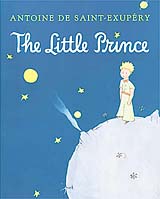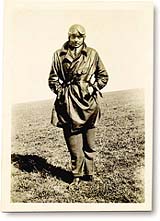|
|
June 25, 2000
BOOKEND / By STACY SCHIFF
Par Avion
arely have an author and a character been so intimately bound together as Antoine de Saint-Exupéry and his Little Prince. They make for an odd couple: the hulking, balding aviator who preferred stapling to buttoning his shirts; the dapper little extraterrestrial with the mop of golden curls and what seems an extensive wardrobe for someone who hails from an asteroid the size of a house. Where the Little Prince religiously tends his planet, his creator was a champion procrastinator. (If the wreckage found off the coast of Marseille this spring, weeks before Saint-Exupéry's centennial, proves to be that of his lost World War II airplane, it will be one of the first occasions on which he has turned up on time.) The Little Prince is a determined walker; Saint-Exupéry -- the toast of every cabdriver in Paris -- was allergic to exercise. He had no use for nature. Yet the two remain tangled together, twin innocents who fell from the sky.
It was not always so. Reviewers of 1943 assumed the novel's narrator -- the downed pilot who befriends the Little Prince and elicits the story of his travels -- was Saint-Exupéry. This was as much the publisher's doing as anything else; the oddball volume was advertised everywhere as ''a story of St. Exupery and the desert.'' Inadvertently the author assisted in the conflation; in its April 26, 1943, issue, Time reported that he had ''last fortnight left the U.S. for active service against the Axis in Africa.'' Weeks later, after having bent a few rules, and to his immense satisfaction, he began flying again with his old reconnaissance squadron. His publisher celebrated with a press release, one that ended in a postscript: ''Although he is in the general neighborhood where the Little Prince appeared to him, he has not seen him again.''

Fondation Saint-Exupéry (above)Saint-Exupéry, above, aviator and author of "The Little Prince." Related Article
Romance of a Prickly Rose and a Starry Prince (June 7, 2000)
Saint-Exupéry's friends saw a good deal of the Little Prince, however. The author waved the book around proudly, boyishly, as if handing over a kind of personal manifesto. He demanded reader's reports from those who asked to borrow a precious copy. (The volume was not published in occupied France, where all of Saint-Exupéry had fallen out of print, and was banned in North Africa.) His letters are punctuated with versions of the flying figure, soon grounded and disconsolate, as Saint-Exupéry was himself to be, having clumsily damaged an $80,000 airplane in the middle of a war. Only in the spring of 1944 did he manage to talk his way back into active service, in a plane into which he did not fit, that he could not comfortably fly, communicating with the control tower in a language he did not speak. Over the next months he knew every kind of near disaster. He experienced engine trouble and landing difficulties, he fainted in flight, he was pursued by enemy aircraft, he battled a fire on board. Any one of his 1944 missions could have been his last.
On July 31, 1944, he disappeared, under circumstances upon which has swelled a great grassy knoll of literature. In much the same fashion as the Little Prince, Saint-Exupéry vanished into thin air. This was enough to assure his legend. (Insofar as he died for his country, his was also a death that extended the French copyrights in his work for an additional 30 years.) ''The Little Prince'' read differently in France in 1945, where it was published after the liberation, than it had in America in 1943; to the French reader it amounted to an eerie chronicle of a death foretold. The mystery surrounding the disappearance has only enhanced the myth. From the Titanic to the Loch Ness monster, we cannot resist the appeal of the large object that slips suddenly from view.
Clinching the equation of author and character, beckoning to the mystic interpreters, is the curious matter of the sunsets. Saint-Exupéry met his end weeks after his 44th birthday. The Little Prince lives on a planet so small that he is able to watch the sun set 44 times a day. Case closed for the suicide contingent. There is only one small problem. The Little Prince indeed witnesses 44 sunsets in the Katherine Woods rendering, as it seems he will continue to do in Richard Howard's sparkling new translation of the novel, published this month. But in French the sun fades from the Little Prince's view as it always has: 43 times.
Books have lives -- The Little Prince'' has had at least two, and on the occasion this week of Saint-Exupéry's centenary is about to enjoy another -- and they have legacies. As J. M. Barrie's massive oeuvre has been eclipsed by the shadow of Peter Pan, so has Saint-Exupéry dissolved largely into the author of a children's classic. The volume has been as kind to his royalty account as it has been detrimental to his reputation; the successful children's book writer is one of those thankless half-breeds, like the academic celebrity, the child star. Saint-Exupéry's fall from literary grace begins with ''The Little Prince'' in his native country, where he is the Norman Rockwell of letters. His offenses are legion. As one French apologist has it: ''He manages to eschew Cartesian thinking, to sidestep the subtlety of our rhetoricians, to rise above our Talmudic taste for criticism -- in short, to escape all of our national vices.'' Most maddeningly, Saint-Exupéry refuses to subscribe to schools; he slips through nets. This was, after all, a writer who won both the Academie Fran-->aise's fiction prize and the American Booksellers Association's nonfiction prize for ''Wind, Sand and Stars,'' who got himself condemned as a Vichyite and banned for singing the praises of a Jew all at once.
''Nothing is perfect,'' sighs the Little Prince's fox, trading on his creator's wisdom. Even on a good day the road to immortality has been as convoluted for Saint-Exupéry as was the mortal one. In 1992 the Banque de France resolved to feature an aviator on one of its new bills. A poll was conducted; France's most celebrated flier was determined to be Jean Mermoz. Mermoz was a stellar and unflappable pilot, a better pilot than Saint-Exupéry, but he also happened to have a few unfortunate ideas about fascism. Under a Socialist administration he hardly qualified as banknote material. Saint-Exupéry profited from his disaster and today graces the 50-franc note by default. Which did not guarantee that his name would be spelled correctly on the original issue of the bill.
Just as each generation embraces its favorite flier, so have we had several Saint-Exupérys. This is not surprising; for years the French biography of record was Pierre Chevrier's 1949 ''Antoine de Saint-Exupéry,'' a volume beside which Edmund Morris's ''Dutch'' looks slavishly literal. Pierre Chevrier was none other than Nelly de Voge, Saint-Exupéry's longtime mistress. Dashing into a phone booth, she emerges as ''un ami'' whenever she needs to enter her text. Needless to say, Saint-Exupéry's wife, Consuelo, is mentioned only in passing. Posthumously, Mme. de Saint-Exupéry is enjoying her revenge. Reworked by a critic, her memoirs -- bearing the seductive belly band ''Le Manuscrit Retrouvé de la Femme de Saint-Exupéry'' -- have become a best seller in France. (They were not so much recovered as finally released by her executor, who -- appropriately for the woman who advertised herself as the model for the Little Prince's melodramatic rose -- happened also to be her gardener.) Consuelo's pages ''topple the statue of our hero, supplying damning evidence for the prosecution,'' trumpeted L'Express, although the ''memoir'' reveals very little that is new. A portrait of marital bliss was not to be expected from the party whom Saint-Exupéry crisply informed, ''If you're not here I can't think, and if you talk I can't write.'' Two additional volumes devoted to Consuelo join her own in Parisian bookstores this month. Both take as their basis the idea that ''The Little Prince'' is the story of a man's struggle with his marriage, which it is, every bit as much as it is a volume that read backward reveals that the Lindbergh baby was acting alone in Roswell.
As always, the other shoes drop slowly. Now we have Consuelo, but sometime down the road we will have another piece of the story, the intoxicating love letters Saint-Exupéry wrote Nelly de Voge. (''They will not be published until after you are dead,'' she informed this biographer, 45 years her junior.) Additional documents will reframe that publication; the man who expounded so eloquently on duty was perfectly capable of confessing his love to two different women on the same afternoon. All the same, a consistent image emerges. ''Pierre Chevrier'' tells of Saint-Exupéry having forced Benzedrine down her throat so that she might read his new pages with unflagging attention. What should our hero do in the course of his first evening with Consuelo but ply her with sedatives? Small wonder the man has not often been allowed to venture out with a biographer unchaperoned.
Above all, Saint-Exupéry's heirs have sought to protect him from the indignity of a barnacle-encrusted P-38 rising from the ocean. Can the myth survive the solution to the riddle of Saint-Exupéry's death? What happens when his fate and the Little Prince's no longer coincide? Does the book lose its allure, in all the 95 languages in which it is published? Once again we are on the verge of answering those questions. The identity bracelet fished from an inlet off Marseille in 1998 appears to be authentic; the airplane parts currently under investigation turned up only a mile away. Saint-Exupéry may not slip through the net this time. All the same, the question of how he went down may never be solved; it is highly improbable that he was shot from the sky. It seems that the essential will remain invisible to the eye, and Saint-Exupéry will remain as maddeningly, irresistibly elusive as ever.
For his part the blue-booted Little Prince has never stood so solidly on this planet. The dolls are in stores already.
Stacy Schiff is the author of ''Saint-Exupéry: A Biography.'' Her ''Vera (Mrs. Vladimir Nabokov)'' won this year's Pulitzer Prize for biography.
|
Home | Site Index | Site Search | Forums | Archives | Marketplace Quick News | Page One Plus | International | National/N.Y. | Business | Technology | Science | Sports | Weather | Editorial | Op-Ed | Arts | Automobiles | Books | Diversions | Job Market | Real Estate | Travel Help/Feedback | Classifieds | Services | New York Today Copyright 2000 The New York Times Company
|
